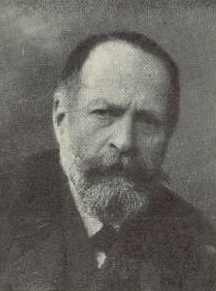
Gyula Donáth
Encyclopedia

Hungary
Hungary , officially the Republic of Hungary , is a landlocked country in Central Europe. It is situated in the Carpathian Basin and is bordered by Slovakia to the north, Ukraine and Romania to the east, Serbia and Croatia to the south, Slovenia to the southwest and Austria to the west. The...
sculptor.
He was born in Pest and studied in Vienna with G. Semper. From 1880 onwards he worked in Budapest
Budapest
Budapest is the capital of Hungary. As the largest city of Hungary, it is the country's principal political, cultural, commercial, industrial, and transportation centre. In 2011, Budapest had 1,733,685 inhabitants, down from its 1989 peak of 2,113,645 due to suburbanization. The Budapest Commuter...
. His sculptural style integrated elements of classicism
Classicism
Classicism, in the arts, refers generally to a high regard for classical antiquity, as setting standards for taste which the classicists seek to emulate. The art of classicism typically seeks to be formal and restrained: of the Discobolus Sir Kenneth Clark observed, "if we object to his restraint...
and academic as well as the Art Nouveau
Art Nouveau
Art Nouveau is an international philosophy and style of art, architecture and applied art—especially the decorative arts—that were most popular during 1890–1910. The name "Art Nouveau" is French for "new art"...
styles. Much of his output as a sculptor was creating plastic art for tombs, though he also created public monuments for both the Millennium of Hungary (1898) and the Imperial Jubilee, (1908). It was Donáth who sculpted the "Statue of Werbőczi" (since then demolished).
Donáth's huge bronze Turul
Turul
The Turul is the most important bird in the origin myth of the Magyars .It is a divine messenger, and perches on top of the tree of life along with the other spirits of unborn children in the form of birds...
on the railing of Buda Castle
Buda Castle
Buda Castle is the historical castle and palace complex of the Hungarian kings in Budapest, first completed in 1265. In the past, it was also called Royal Palace and Royal Castle ....
, high above the Danube, was erected in 1905. It is one of the symbols of Budapest
Budapest
Budapest is the capital of Hungary. As the largest city of Hungary, it is the country's principal political, cultural, commercial, industrial, and transportation centre. In 2011, Budapest had 1,733,685 inhabitants, down from its 1989 peak of 2,113,645 due to suburbanization. The Budapest Commuter...
.

- The representation of women in Art Nouveau is limited to iconographical types developed from a preoccupation with relatively few themes: the mystery of life and death, the relationship between the sexes, and women as an emblem of whatever was enigmatic or mysteriously attractive."
The author then goes on to include Donáth's opus Song of Lament as an example. (Berend)
Donáth died in Budapest
Budapest
Budapest is the capital of Hungary. As the largest city of Hungary, it is the country's principal political, cultural, commercial, industrial, and transportation centre. In 2011, Budapest had 1,733,685 inhabitants, down from its 1989 peak of 2,113,645 due to suburbanization. The Budapest Commuter...
.
Sources & resources
- Berend, Ivan T., A Golden Age: Art and Society in Hungary 1896 - 1914, Corvina/Barbican Art Gallery, Miami, Florida 1990
- Mackay, James, The Dictionary of Sculptors in Bronze, Antique Collectors Club, Woodbridge, Suffolk 1977

